| |
NIH Workshop on HIV-Associated Comorbidities, Coinfections, and Complications: Summary and Recommendation for Future Research
|
| |
| |
Download the PDF here
JAIDS Jan 1 2021 - Savita Pahwa, MD,a Steven Deeks, MD,b Shimian Zou, PhD,c Natalie Tomitch, MPH, MBA,d
Leia Miller-Novak, PhD,e Elisabet Caler, PhD,c Amy Justice, MD, PhD,f Ned Sacktor, MD,g
Dana Gabuzda, MD,h Peter W. Hunt, MD,b Todd Brown, MD, PhD,g Ann Kurth, RN, PhD,i
Stefan Baral, MD,j Michael Mugavero, MD, MHSc,k Kenneth H. Mayer, MD,l
Emily Mendenhall, PhD, MPH,m Roger Detels, MD,n and Vincent Mutabazi, MD, MSco
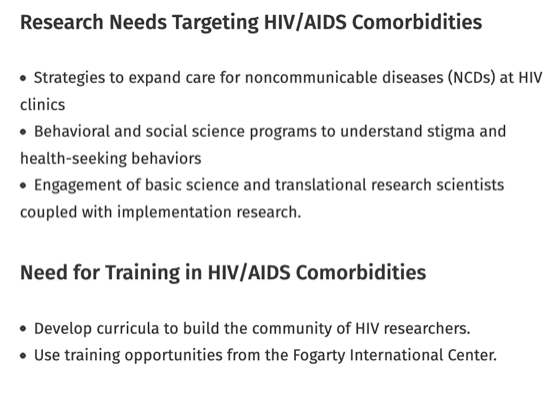
Abstract
Background:
With potent antiretroviral therapy and simplified regimens, people living with HIV (PWH) are achieving near-normal lifespans but not necessarily a normal health span or healthy aging. PWH have a higher than expected risk of developing a number of non-AIDS comorbidities, coinfections, and complications (CCC), often against a background of stigma, poverty, and isolation.
Setting:
To gain a better understanding of research needs for HIV-associated CCC, the NIH convened a 2-day workshop (HIV-associated CCC, or HIV ACTION).
Methods:
A cross-institute NIH planning committee identified 6 key research areas: epidemiology and population research, pathogenesis and basic science research, clinical research, implementation science research, syndemics research and international research in low and middle income countries. Investigators were selected to lead working groups (WGs) to assess the state-of-the-art and identify 3–5 priority areas in each field before the workshop. A 2-day program at the NIH was developed which included presentations by invited experts and WG members.
Results:
Over 400 participants attended the workshop. After general and individual WG discussions, the most pressing gaps, questions, or proposed action items were identified. Priority lists of pressing research issues were presented by cochairs of each WG. A detailed report is posted at the NHLBI website. This article reports the streamlined priority list and a summary of WG discussions to inform investigators of current priorities in the field.
Conclusion:
Collaborative efforts of many disciplines are needed to improve the health and wellbeing of PWH. Several common themes emerged across WG representing potential priorities for investigators and recommendations for the NIH.
After the breakout sessions, Mr. Jules Levin of the National AIDS Treatment Advocacy Project (NATAP) presented his perspective on aging with HIV in the United States, specifically focusing on unmet needs such as those related to clinical care, community care and services. He proposed an implementation study to evaluate a new care model which includes longer visit times with the clinician, geriatric care in the clinic, IT/telemedicine visits for patients, better communication and coordination among primary care providers, specialists and people living with HIV, and other elements.
Details of the process, agenda, executive summary, detailed report, and outcomes were posted on the NHLBI website:
https://www.nhlbi.nih.gov/events/2019/hiv-associated-comorbidites-co-infections-complications-workshop.
For the full recap, please see below:
NIH Comorbidities Workshop Summary
PDF 1 MB
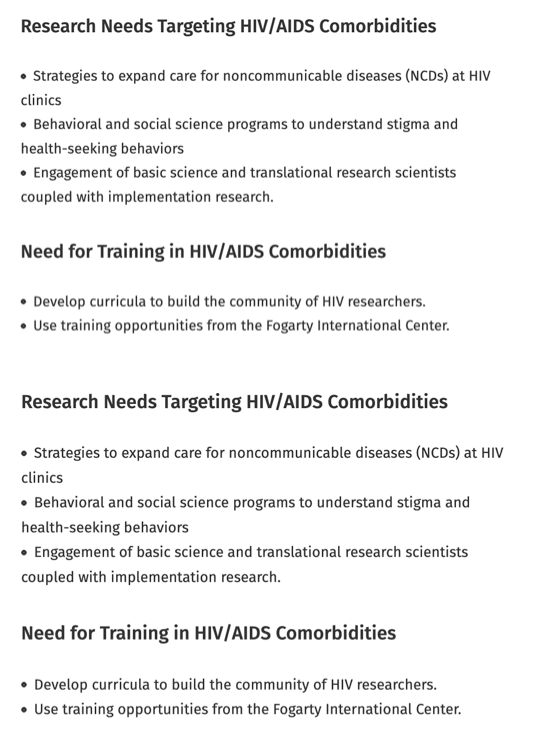
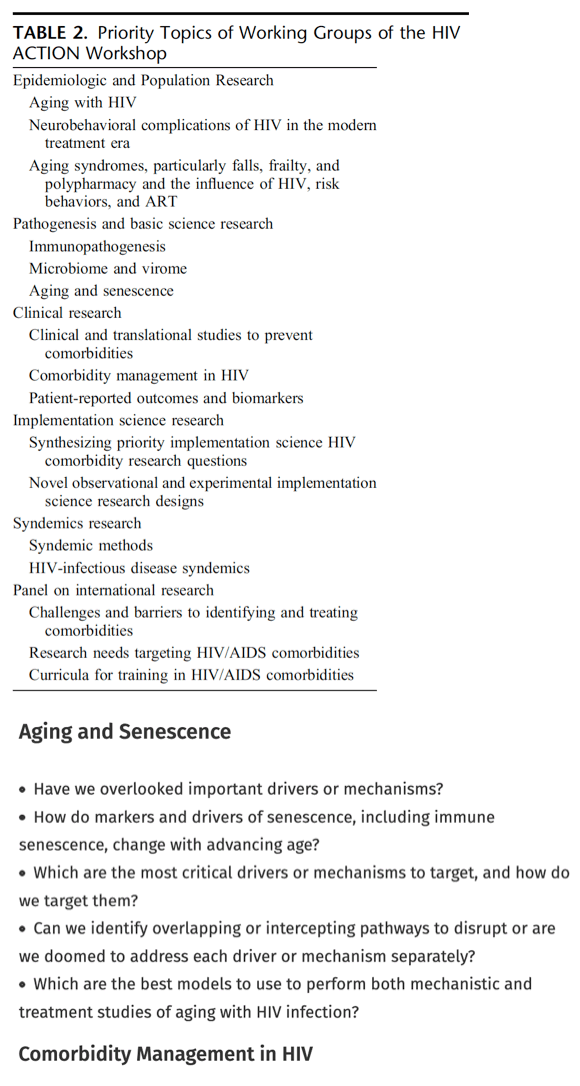
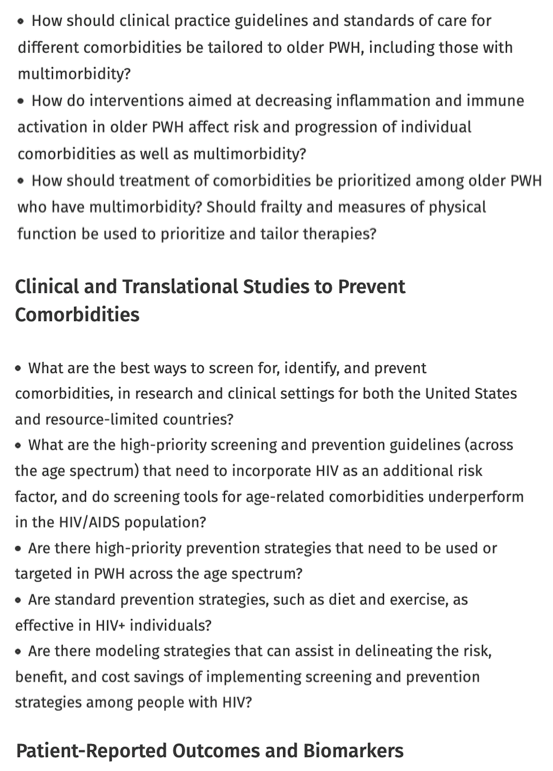
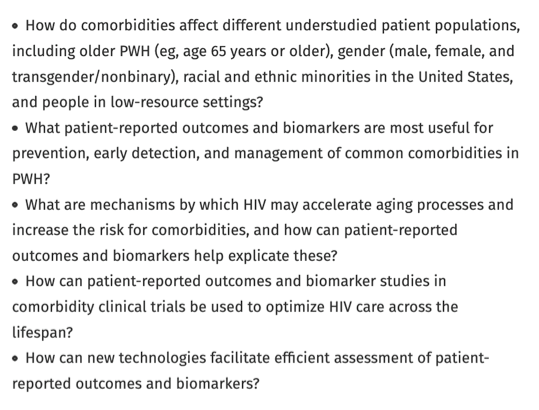
DISCUSSION
This NIH-sponsored initiative involved multiple experts and stakeholders in an effort that was sustained for over 12 months, culminating in a highly interactive 2-day conference. During this process, it became apparent that cross-disciplinary (and hence at the NIH, cross-institute) collaboration will be necessary to accelerate progress in studies aiming to improve the quality and quantity of life for PWH in the era of ART and for bridging the gap between chronologic age (lifespan) and complex biologic processes that affect it (healthspan). With the momentum of the President's initiative to end the HIV epidemic (EHE), greater numbers of PWH will enter into care under the "diagnose" and "treat" pillars and the people aging with HIV will continue to grow. From the community perspective, the need for new models of research providing real time data about clinical needs, care, and implementation of services for people aging with HIV was emphasized. The impact of social, cultural, economic, political, and other factors on the susceptibility for HIV and coconditions has major implications for a disease that is increasingly concentrated in vulnerable populations, yet how these societal factors affect health in PWH is largely undefined. Several common themes emerged that highlight priority areas for investigators and recommendations for the NIH. Salient discussion points, research priorities, and recommendations emerged from the various working groups, underscoring the importance of community engagement in decision making.
The epidemiologic and population research working group discussed comorbidities6 and raised questions about the differences in aging with and without HIV infection. Multiple factors likely contribute to health in aging HIV-infected adults, including the direct impact of HIV infection on multiple organ systems, toxicity of ART, polypharmacy, social isolation, stigma, and others as yet poorly defined risk factors. Notably, most of these factors are known to affect aging in the general population but are overrepresented or more pronounced in PWH. Frailty, for example, is often discussed in the context of HIV disease and aging, but how this should be defined and measured in HIV populations is not known. The importance of studying neurocognition, the roles of polypharmacy, and substance use in neurocognitive compromise in people aging with HIV was highlighted. Tools are needed to help identify common pathways for multimorbidity, for clinical phenotype definitions and practical guidance for clinical management. The group's recommendations included cataloging and developing tools to assess exercise, frailty and fall risk, brain health and cognitive decline, and to capture social factors with qualitative research, machine learning approaches on large data sets and polypharmacy research.
The pathogenesis and basic science research working group proposed that underlying pathogenesis and mechanisms of HIV-associated CCC that involve multiple systems and manifest as concurrent conditions in PWH may be fundamentally different from the same "diagnosis" in persons without HIV along the lifespan.5 The appropriate phenotypes, indicators, and indices/biomarkers for research on HIV-associated CCC will likely prove to be unique among those with and without HIV.7–9Factors that drive chronic immune activation and dysfunction in treated HIV infection, shared immune pathways and microbiome/virome contributions toward inflammation/chronic immune activation and immune dysfunction, and mechanisms that drive accentuated aging are among the overlapping etiologies and pathogenesis mechanisms.10–12 New research methods or technologies, including appropriate animal models13 are needed for research of HIV-associated CCC across the lifespan. Ultimately, there is a need to move toward interventional studies using knowledge gained from basic research. As PWH on ART inch closer to the healthy non-HIV aging population in longevity, a proposal for inclusion rather than exclusion of PWH from clinical trials investigating new therapeutic modalities in emerging fields such as geroscience was recommended.14
The clinical research working group discussed different comorbidities associated with HIV and prioritized prevention, management, patient-reported outcomes, and biomarkers.15 Discussions included the need for research to design better screening tools for the early detection of age-related comorbidities including cardiovascular and musculoskeletal diseases in PWH and whether more aggressive management of blood pressure or cholesterol would alleviate the difference in outcomes of treatment in PWH and general populations.
As research moves forward, patient-reported outcomes will need to be measured more carefully. There is also a need for clinical trials that are not limited to specific diseases. It will be important to think more broadly and more holistically. The working group's discussions highlighted several principles, including the importance of addressing a life course perspective, disparities (including African Americans and other vulnerable populations), and age, sex, gender, and sexual orientation issues, given the disproportionate burden of several age-related comorbidities in women living with HIV. It was also recommended that funding calls should solicit applications from both international and domestic perspectives.
The syndemics research working group discussions focused largely on definitions. Members emphasized how local context matters and how strong the impact of social determinants of disease is.16–19 Several overall priority questions were addressed. When is something syndemic and when is it not? How does the syndemic approach advance our understanding of mitigating upstream or clinically to make the biggest impact? Why does syndemic thinking matter for HIV? The discussions highlighted the importance of syndemics research for characterizing and integrating various comorbid diseases/disorders and their synergistic effects in PWH, while taking into account social, political, and ecological factors. The group discussed how to intervene upstream to mediate the emergence and interaction of multiple conditions that cluster with HIV. Focusing on nonmedical contributors and interventions at the policy and clinical level was emphasized. Such research can help us gain a deeper understanding of the interplay between these factors and their role in promoting disease clustering at the population level, and the impact they have on disease pathologies at the individual level; findings of such research will encourage more holistic approaches in the clinical management of PWH.
The implementation science research working group introduced a theoretical and foundational discussion of methods. Implementation science is an emerging area for HIV-related research,20 and hence, coordinated support is needed for development of new observational and experimental implementation research designs and for training, including leverage of existing training opportunities and resources. What combination of implementation strategies would be necessary and sufficient to increase the impact of interventions for HIV-related comorbidities was a discussion theme. Recommendations included bringing implementation scientists to the table early to help determine which approaches have the most impact for HIV-associated comorbidity and optimal designs for evaluation, and to learn from implementation science research that has been conducted outside the HIV setting. Moreover, how can we better use nonexperimental designs including quasiexperimental and natural experiments to provide insight into outstanding research priorities for HIV-related comorbidity research. In resource-limited settings, we can learn about screening, diagnosis, and management of HIV-related comorbidities that will be relevant to the care of PWH. Implementation science methods and strategies will be essential to address barriers that impede the scale-up and application of scientifically proven interventions in community and clinical settings for the prevention, control, and treatment of HIV-associated CCC in PWH.
The international working group was comprised of representatives from each of the other 5 WG and covered areas discussed by other WG in the context of low-income and middle-income countries. Establishment of behavioral and social science research priorities that include the roles of stigma pervading all aspects of HIV, unique aspects of sex and gender in developing strategies to expand care for NCDs at HIV clinics. Engagement of translational and basic scientists and implementation perspectives in international settings is critical. Adequate funding streams are needed to deliver effective primary care, and improved data collection on comorbidities for reliable estimates of the global burden of NCD that differs from country to country and will be essential for large-scale system changes in delivering health care, utilization of tools such as The World Health Organization's STEPwise approach to Surveillance (STEPS) methodology. The IeDEA network, spanning 42 countries, the PEPFAR Population HIV Impact Assessment surveys and Demographic and Health Survey Program tools for HIV+ populations were discussed. The group underscored the commitment of the Fogarty International Center to supporting training in developing countries.
A sentiment echoed by various experts was that in addition to efforts targeting specific research priorities within the mission of each Institute and Centers (IC), a coordinated NIH-wide research strategy would go a long way in addressing the complexities of CCC. For example, intervention research for prevention and management of HIV-associated CCC and their attendant polypharmacy is challenging.21 For addressing comorbidities, whether an intervention should be targeted for a specific condition or be directed at generalized chronic immune activation and inflammation is not known. Understanding basic mechanisms as well as safety and effectiveness of interventions to control inflammation and immune activation in PWH should be of interest to many NIH ICs but would be costly and better served by coordinated research efforts. Multidisciplinary strategies fostering innovative research funding models and a nonsiloed approach could best address the common research themes that emerged from the workshop. In particular, funding mechanisms that promote multimorbidity research and collaboration would be beneficial, for example, multiomics approaches and large cohorts requiring collaboration across institutes, centers, and offices of NIH. Having NIH-wide discussion on how to facilitate and fund such collaboration was recommended as a priority. The authors recognize limitations of the prescriptions offered by the workshop summary, as viewpoints of all the diverse stakeholders affected by HIV comorbidities are not represented.

|
|
| |
| |
|
|
|